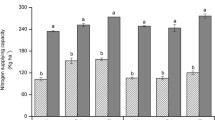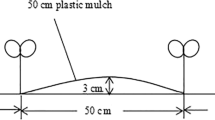Abstract
Long-term field experiments (3–4 years) were conducted to evaluate the residual effect of boron (B) fertilizer for oilseed rape (Brassica napus L.) in an intensive crop rotation including two rice (Oryza sativa) crops per year. Experiments were conducted on four sites where the soil types were sandy, silty and clayey Inceptisols, and an Ultisol, located in the Zhejiang Province, Southeast China. Application of B fertilizer at rates of 1.1, 1.65 and 3.3 kg B/ha in the first year showed a different residual effect on oilseed yield in successive years, but had only small positive effects on the rice grain yield at two sites. The residual effect of 1.1 kg B/ha remained fully effective in correcting B deficiency in oilseed rape for 2 years in the Inceptisols, whereas the residual effect of 1.65 kg B/ha continued to correct B deficiency for at least 3 years in both the Inceptisols and the Ultisol. Foliar application of B fertilizer generally corrected B deficiency for oilseed rape but showed limited residual effect in the following years after application. The decline in residual values of B from a single fertilizer addition was closely related to the soil and leaf B concentration. Soil available B also decreased dramatically with the advance of rotation, but a larger decrease was found at a depth of 20–40-cm for the Inceptisols and the Ultisol. Thus, a more detailed understanding of the B cycling in the system is now needed to optimize management of B fertilizer.
Similar content being viewed by others
References
Al-Muastafa WA, Falatah AM & El-Shall AA (1993) Effect of excess boron fertilization on status and availability of boron in calcareous soils. Fertil Res 36: 71–78
Blevins DG, Scrivner CL, Reinbott TM & Schon MK (1995) Foliar boron increases berry number and yield of two highbush blueberry cultivars in Missouri J Plant Nutr 19: 99–13
Cassman KG, Peng S & Dobermann A (1997) Nutritional physiology of the rice plant and productivity decline of irrigated rice systems in the topics. In: Ando T, Fujita K, Mae T, Matsumoto H, Mori S & Sekiya J (eds). Plant Nutrition for Sustainable Food Production and Environment. Development in Plant and Soil Sciences, Vol 78, pp 783–788. Kluwer Academic Publishers, Dordrecht, The Netherlands
Dongale, JH & Zande GK (1977) Residual effect of micronutrients applied to groundnut crop on the grain yields of succeeding wheat crop. Indian J Agron 22: 110–116
Gaines TP & Mitchell GA (1979) Boron determination in plant tissue by zomethine-H method. Commun Soil Sci Plant Anal 10: 1099–1108
Gerath H, Borchmann W & Zjonc I (1975) Crop yield development of winter rape (Brassica napus L. ssp oleifera) as influenced by the micronutrient boron. Arch Acker Pflanzenbau Bodenkunde Berlin 19: 781–792
Gupta UC (1984) Boron nutrition of alfalfa, red clover, and timothy grown on podzol soils of Eastern Canada. Soil Sci 13: 16–20
Gupta UC & Cutcliffe JA (1978) Effects of method of boron application on leaf tissue concentration of boron and control of brown-heart of rutabaga. Can J Plant Sci 58: 63
Gupta UC & Cutcliffe JA (1984) Effects of applied and residual boron on the nutrition of cabbage and field beans. Can J Soil Sci 64: 571–574
Heitholt JJ (1994) Supplemental boron, boll retention percentage, ovary carbohydrates, and lint yield in modern cotton genotypes. Agron J 86: 492–497
Hu Q, Xu G, Shi R & Zhu J (1992) Study on boron nutrition of oilseed rape with low erucic acid content. Nanjing Nongye Daxue Xuebao 15: 53–56 (in Chinese)
Huang L, Ye ZQ & Bell RW (1996) The importance of sampling young leaves for the diagnosis of boron deficiency in canola (Brassica napus). Plant Soil 183: 187–198
Jahiruddin M, Hoque MS, Haque AKMM & Roy PK (1992) Influence of boron, copper and molybdenum on grain formation in wheat. Crop Res (Hisar) 5: 35–42
Krauze A, Benedycka Z & Bobrzecka D (1988) Effective of boron in a four-year rotation. Acta Academiae Agriculturae ac Technicae Olstenensis. Agricultura 45: 53–59
Krauze A, Bowszys T, Bobrzecka D & Rotkiewicz D (1991) Effect of foliar boron fertilization on yield and quality of winter rape. In: McGregor DI (ed) Proc. Eighth Int. Rapeseed Congress, pp 547–553. Saskatoon Canada.
Liu Z, Zhu QQ & Tong LH (1982) On the status of microelements in soils and their role in crop production of China Int Conf Chem and World Food Supplies. Manila, Phillipines, Dec. 1982
Maharana DP, Sarengi SK & Ali MH (1993) Response of rice to boron in red and yellow soils of Mayurbhanj district of Orissa. Hindustan Fertilizer Corporation: 254–262
Mortvedt J & Woodruff JR (1993) Technology and application of boron fertilizers for crops. In: Gupta UC (ed) Boron and its Role in Crop Production, pp 157–176. CRC, Boca Raton, FL USA
Myers LF, Lipsett J & Krirchner R (1983) Response of rapeseed (Brassica napus) to phosphorus, boron and lime on an acid soil near Canberra. Aust J Exp Agric Anim Husb 23: 172–177
Parker DR & Gardner EH (1982) Factors affecting the mobility and plant availability of boron in someWestern Oregon soils. Soil Sci Soc Am J 46: 573–578
Pinyerd CA, Odom JW, Long FL & Dane JH (1984) Boron movement in a Norfolk loamy sand. Soil Sci 137: 428–433
Rerkasem B & Jamjod S (1989) Correcting boron deficiency induced ear sterility in wheat and barley. Thai J Soils Fertil 11: 200–209
Saaerela I (1985) Plant-available boron in soils and the boron requirement of spring oilseed rapes. Ann Agric Fenn 24: 183–265
Shorrocks VM (1987) Citrus-residual boron effects. Micronutrient News 8: 7–8
Spouncer LR, Nable RO & Cartwright B (1992) A procedure for the determination of soluble boron in soils ranging widely in boron concentrations, sodicity and pH. Commun Soil Sci Plant Anal 23: 441–153
Sylvester-Bradley R & Makepeace RJ (1984) A code for stages of development in oilseed rape. Aspects Appl Biol 6: 399–419
Wang K, Xu JM, Wei YZ, Yang Y & Bell RW (1997) The influence of boron fertilizer on distribution of extractable boron in soil profiles in rape– rice rotations in south east China. In: Bell RW & Rerkasem B. (eds) Boron in Soils and Plants. Development in Plant and Soil Sciences, Vol. 76, pp 57–61. Kluwer Academic Publishers, Dordrecht, The Netherlands
Wang K, Yang Y, Bell RW, Xue JM, Ye ZQ & Wei YZ (1998) Low risks of toxicity from boron fertilizer in oilseed rape– rice rotations in south east China. Nutr Cycl Agroecosyst 57: 189–197
Wear JI (1957) Boron requirements of some crops in Alabama. Alabama Agric Exp St Bull 305
Wei Y, Bell RW, Yang Y, Ye Z, Wang K & Huang L (1998) Prognosis of boron deficiency in oilseed rape (Brassica napus) by plant analysis. Aust J Agric Res 49: 867–874
Yang Y, Xue J, Ye JQ & Wang K (1993) Response of rape genotypes to boron application. Plant Soil 155/156: 321–324
Ye ZQ, Bell RW, Yang Y, Wang K, Xue JM, Wei YZ, Xu JM & Yang X (1999) Responses of transplanted oilseed rape (Brassica napus L.) to boron in south east China. Field Crops Res (in press)
Zarcinas BA (1995) Suppression of iron interference in the determination of boron using the azomethine-H procedure. Commun Soil Sci Plant Anal 26: 713–729
Author information
Authors and Affiliations
Rights and permissions
About this article
Cite this article
Yang, X., Yu, Y., Yang, Y. et al. Residual effectiveness of boron fertilizer for oilseed rape in intensively cropped rice-based rotations. Nutrient Cycling in Agroecosystems 57, 171–181 (2000). https://doi.org/10.1023/A:1009837120062
Issue Date:
DOI: https://doi.org/10.1023/A:1009837120062




